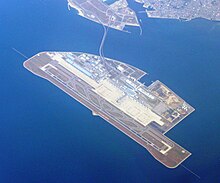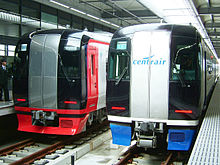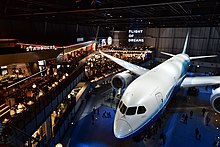Chubu Centrair International Airport
Chubu Centrair International Airport 中部国際空港 Chūbu Kokusai Kūkō | |||||||||||
|---|---|---|---|---|---|---|---|---|---|---|---|
 | |||||||||||
| |||||||||||
| Summary | |||||||||||
| Airport type | Public | ||||||||||
| Owner/Operator | Central Japan International Airport Co., Ltd. (CJIAC) | ||||||||||
| Serves | Nagoya, Japan | ||||||||||
| Location | Tokoname, Aichi, Japan | ||||||||||
| Opened | 17 February 2005 | ||||||||||
| Hub for |
| ||||||||||
| Focus city for |
| ||||||||||
| Elevation AMSL | 12 ft / 4 m | ||||||||||
| Coordinates | 34°51′30″N 136°48′19″E / 34.85833°N 136.80528°ECoordinates: 34°51′30″N 136°48′19″E / 34.85833°N 136.80528°E | ||||||||||
| Website | (in English) www.centrair.jp | ||||||||||
| Map | |||||||||||
 RJGG Location in Aichi Prefecture | |||||||||||
| Runways | |||||||||||
| |||||||||||
| Statistics (2018) | |||||||||||
| |||||||||||
Source: Japanese Ministry of Land, Infrastructure, Transport and Tourism[1] | |||||||||||
Chubu Centrair International Airport (中部国際空港, Chūbu Kokusai Kūkō) (IATA: NGO, ICAO: RJGG) is an international airport on an artificial island in Ise Bay, Tokoname City in Aichi Prefecture, 35 km (22 mi) south of Nagoya in central Japan.[2]
Centrair is classified as a first class airport and is the main international gateway for the Chubu ("central") region of Japan. The name "Centrair" (セントレア, Sentorea) is an abbreviation of Central Japan International Airport, an alternate translation used in the English name of the airport's operating company, Central Japan International Airport Co., Ltd. (中部国際空港株式会社, Chūbu Kokusai Kūkō Kabushiki-gaisha). 10.2 million people used the airport in 2015, ranking 8th busiest in the nation, and 208,000 tons of cargo was moved in 2015.
History[]

Chubu Centrair serves the third largest metropolitan area in Japan, centered around the city of Nagoya. The region is a major manufacturing centre, with the headquarters and production facilities of Toyota Motor Corporation and production facilities for Mitsubishi Motors and Mitsubishi Aircraft Corporation.[3]
With much lobbying by local business groups such as Toyota, especially for 24-hour cargo flights, construction started August 2000, with a budget of JPY¥768 billion (€5.5 billion, US$7.3 billion), but through efficient management nearly ¥100 billion was saved.[4] Penta-Ocean Construction was a major contractor.[5]
According to Japanese media sources, Kodo-kai, a Yakuza faction in the Yamaguchi-gumi group, earned an immense amount of money by being the sole supplier, via a front company called Samix, of dirt, rock, sand, and gravel for the airport construction project. Although several Samix executives were criminally indicted for racketeering, the prosecutions were later dropped. According to the sources, Kodo-kai had informants working within the Nagoya police who fed the organization inside information which allowed them to stay a step ahead of investigating authorities.[6]
When Chubu Centrair opened on 17 February 2005, it took over almost all of the existing Nagoya Airport's (now Nagoya Airfield) commercial flights, and relieved Tokyo and Kansai areas of cargo shipments. As a replacement for Nagoya Airport, it also inherited its IATA airport code NGO. The airport opened in time to service the influx of visitors for Expo 2005, located near Nagoya. The airport is speculated to have some competition with Shizuoka Airport, which opened on 4 June 2009.
Route withdrawals[]
There were several withdrawals from Chubu Centrair after the airport commenced its operation. American Airlines operated a route to Chicago for less than seven months in 2005, but said the service was "not as profitable as we had hoped".[7] In 2008, after a few years of service from Chubu Centrair, several airlines cancelled certain flights and put others on hiatus, including Malaysia Airlines' suspension of flight to Kuala Lumpur,[8] Jetstar ending its airport operation, Continental Airlines stopping its Honolulu flight and United Airlines' suspension of flights to San Francisco, citing low premium cabin demand. This flight also continued to Chicago until 2007.[9] Emirates and Hong Kong Express Airways left the airport in 2009, although HK Express resumed service from September 2014. Japan Airlines also ended its flights to Paris in 2009 and Bangkok in 2020. Garuda Indonesia ended service from Denpasar in March 2012, but returned to Nagoya with the opening of direct flights from Jakarta in March 2019 but only lasted until March 2020. EVA Air left the airport in June 2012 (they have since planned to resume service from June 2019). TransAsia Airways subsidiary V Air withdrew from Centrair and ended operations in October 2016.
Nagoya continues to offer intercontinental flights through Delta Air Lines' services to Detroit and Honolulu, Lufthansa's service to Frankfurt and Finnair's service to Helsinki.
Aichi Sky Expo[]
An exposition centre inside the airport island was opened on August 30, 2019. The exposition centre has 6 exhibition halls each being 10,000 m².[10] Events held at the venue include the 2019 edition of the Wired Music Festival on September 7 and 8.[11]
Terminals[]

The northern side of the terminal holds domestic flights, while the southern side holds international flights, each with dedicated ticket counters, security checkpoints and baggage carousels, and for international flights, immigration and customs facilities. Arrivals are processed on the second floor, and departures on the third. The lower level is used for maintenance, catering, and other ground operations, as well as for passenger buses to hardstands in the middle of the airport ramp. There are thirteen gates for domestic flights (including three bus gates), and fourteen for international flights (including three bus gates). Terminal 2 is a domestic and international terminal for budget airlines, with 11 gates for international flights and 9 gates for domestic flights.[12]
Statistics[]
See source Wikidata query and sources.
Airlines and destinations[]
Passenger1[]
| Airlines | Destinations |
|---|---|
| Air Busan | Busan,[13] Seoul–Incheon[14] |
| Air China | Shanghai–Pudong |
| Air Do | Hakodate, Sapporo–Chitose |
| All Nippon Airways | Asahikawa, Fukuoka, Hakodate, Ishigaki, Memanbetsu, Miyako, Nagasaki, Naha, Sapporo–Chitose, Sendai, Tokyo–Haneda Seasonal: Kushiro |
| Asiana Airlines | Seoul–Incheon |
| Cathay Pacific | Hong Kong, Taipei–Taoyuan |
| Cebu Pacific | Manila |
| China Airlines | Taipei–Taoyuan |
| China Eastern Airlines | Beijing–Daxing,[15] Chengdu–Shuangliu, Lanzhou, Qingdao, Shanghai–Pudong, Taiyuan, Xi'an, Yantai |
| China Southern Airlines | Changchun, Changsha, Dalian, Guangzhou, Harbin, Shanghai–Pudong, Shenyang, Wuhan |
| Delta Air Lines | Detroit |
| Etihad Airways | Abu Dhabi, Beijing–Daxing[16] |
| EVA Air | Taipei–Taoyuan |
| Finnair | Helsinki |
| HK Express | Hong Kong |
| Ibex Airlines | Fukuoka, Kagoshima,[17] Kumamoto, Matsuyama, Niigata, Ōita, Sendai |
| Japan Airlines | Honolulu, Sapporo–Chitose, Shanghai–Pudong, Taipei–Taoyuan, Tianjin, Tokyo–Haneda, Tokyo–Narita Seasonal: Obihiro |
| Japan Transocean Air | Naha |
| Jeju Air | Seoul–Incheon |
| Jetstar Japan | Fukuoka, Kagoshima, Manila, Naha, Sapporo–Chitose |
| Juneyao Airlines | Nanjing, Shanghai–Pudong, Wuxi, Xiamen |
| Korean Air | Busan, Seoul–Incheon |
| Loong Air | Hangzhou |
| Lufthansa | Frankfurt |
| Peach | Sapporo–Chitose, Sendai[18] |
| Philippine Airlines | Cebu, Manila |
| Shandong Airlines | Jinan, Qingdao |
| Shanghai Airlines | Guangzhou, Wenzhou |
| Shenzhen Airlines | Beijing–Capital, Wuxi |
| Singapore Airlines | Singapore |
| Skymark Airlines | Kagoshima, Naha, Sapporo–Chitose, Tokyo–Narita |
| Solaseed Air | Kagoshima, Miyazaki, Naha |
| Spring Airlines | Ningbo, Shanghai–Pudong, Shenzhen |
| StarFlyer | Taipei–Taoyuan |
| Thai AirAsia X | Bangkok–Don Mueang |
| Thai Airways | Bangkok–Suvarnabhumi |
| Thai Lion Air | Bangkok–Don Mueang |
| Tianjin Airlines | Tianjin |
| Tigerair Taiwan | Kaohsiung, Taipei–Taoyuan |
| T'way Airlines | Jeju |
| United Airlines | Guam |
| Urumqi Air | Jinan, Urumqi, Wuhan |
| Vietnam Airlines | Hanoi, Ho Chi Minh City |
- Notes
^1 Some destinations may be affected by COVID-19, therefore temporary suspensions are not distinguished as seasonal service.
Cargo[]
| Airlines | Destinations |
|---|---|
| AirBridgeCargo Airlines | Moscow–Sheremetyevo |
| ANA Cargo | Hong Kong, Naha |
| Asiana Cargo | Seoul–Incheon |
| DHL Aviation | Anchorage, Cincinnati, Charleston (SC), Hong Kong, Leipzig/Halle, McConnell AFB, Everett, Seoul–Incheon, Taranto–Grottaglie, Taipei–Taoyuan |
| National Airlines (N8) | Anchorage, Los Angeles |
| Nippon Cargo Airlines | Osaka–Kansai, Tokyo–Narita |
| Transmile Air Services | Kuala Lumpur–International |
| ULS Cargo | Hong Kong, Istanbul–Atatürk |
Ground transportation[]
Train[]

Central Japan International Airport Station, the train station for Centrair is located on the Meitetsu Airport Line operated by Nagoya Railroad (Meitetsu). The fastest "μSky Limited Express" service connects the airport to Meitetsu Nagoya Station in 28 minutes. All μSky Limited Express are operating at a max speed of 120 km/h by 2000 series trains, which have all seats designated and it is required to purchase an extra 360 yen "special limited express ticket".[19] Meitetsu Nagoya Station is adjacent to JR Nagoya Station, allowing transfers to Shinkansen bullet trains bound for not only Tokyo and Osaka but also many major cities, as well as JR, Meitetsu, and Kintetsu local trains, and the Nagoya Municipal Subway.
There is a proposal for a JR line linking Centrair to Nagoya Station and the JR network through Taketoyo Line's Okkawa Station. However, there's no actual construction works have been implemented at the moment.
There's also a proposal for Aonami line linking Centrair to Nagoya Station by constructing a tunnel or bridge. Nagoya municipal government has acted the assessment of feasibility in 2019.[20]
Bus[]
Centrair Limousine provides direct bus service to and from central Nagoya, Sakae, and major hotels.[21] It is operated by a private bus company in Mie Prefecture. High-speed buses to the neighboring prefectures for 3,000 yen to Kyoto via Mie Prefecture have been operating.[22][23]
Ferry[]
A ferry connects to the passenger terminal in Tsu – a 40-minute trip.
Car[]
A toll road links Centrair and the mainland.
Bicycle[]
Bicycles are not allowed on the Centrair Bridge toll road to the mainland. Cyclists departing the airport must either take a Meitetsu local train one stop to Rinkū Tokoname Station or a taxi across the bridge to the Rinkū Interchange north of Aeon Mall Tokoname.
Shopping[]
Centrair features the 4th Floor Sky Town Shopping Center, accessible to the general public, with 61 shops and restaurants. organized into two "streets", Renga-dori[24] and Chochin-yokocho.[25] The Chochin-yokocho shops are individually themed to have an authentic Japanese look.

Entrance to Centrair's 4th Floor Sky Town
Shops in traditional Japanese style
Other facilities[]
The Boeing Dreamlifter Operations Center is located on the airport's apron, to the south of the main terminal. This facility is used to store Japanese components of the Boeing 787 aircraft while awaiting airlift to the assembly facility in the US.[26]
Accolades[]
- 2009: 4th Best Airport in the World of the Airport Service Quality Awards by Airports Council International[27]
- 2011: 5th Best Airport Worldwide of the Airport Service Quality Awards by Airports Council International[28] and Best Airport by Size in the 5 to 15 million passenger category.[29]
- 2015: Skytrax announced Chubu International Airport won the first place in the "Best Regional Airport 2015" award and first place in the "Best Regional Airport – Asia" award for the fifth year running.[30]
- 2016: Skytrax rated Chubu International Airport as the "World's Best Regional Airport 2016" and the 6th "Best Airport Worldwide"[31][32]
- 2017: Chubu International Airport became the first airport in the world to achieve "5-Star Regional Airport Rating" by Skytrax.[33]
- 2018: For 4 consecutive years, Chubu International Airport won "The World's Best Regional Airport" award (Skytrax). Chubu was also ranked the 7th best airport in the world.[34][35]
References[]
- ^ "Chubu International Airport" (PDF). Japanese Ministry of Land, Infrastructure, Transport and Tourism. Archived from the original (PDF) on 21 October 2016. Retrieved 7 January 2017.
- ^ AIS Japan
- ^ "Feb 10, 2005 GOODBYE & AND THANK YOU KOMAKI AIRPORT". Retrieved 7 June 2015.
- ^ "Central Japan International Airport". 23 April 2010. Retrieved 23 March 2014.
- ^ "Centrair Profile and History". airport-technology.com. Retrieved 23 March 2014.[unreliable source?]
- ^ Sentaku Magazine (reprinted in the Japan Times), "Kodo-kai still raking in funds despite tougher yakuza laws", 23 October 2015
- ^ Skertic, Mark (1 October 2005). "American Airlines to end flights to Nagoya, Japan". Chicago Tribune. Retrieved 13 December 2013.
- ^ "LCC eyes Nagoya-Kuala Lumpur runs". Kyodo. 13 September 2013. Retrieved 13 December 2013.
- ^ Brown, Steven (22 July 2008). "United Airlines to stop flying to Nagoya from S.F." San Francisco Business Times. Retrieved 13 December 2013.
- ^ 株式会社インプレス (25 July 2019). セントレア直結の国際展示場「Aichi Sky Expo」公開。ビッグサイト、メッセ、インテックスに次ぐ規模. トラベル Watch (in Japanese). Retrieved 1 November 2019.
- ^ 開催5周年にして初の2DAYS開催でパワーアップ「WIRED MUSIC FESTIVAL‘19」. PR Times (in Japanese). 1 February 2019. Retrieved 4 December 2019.
- ^ "エアポートガイド" (PDF). Chubu Centrair International Airport. Retrieved 13 December 2013.
- ^ "Air Busan adds Busan – Nagoya service from June 2018".
- ^ https://www.routesonline.com/news/38/airlineroute/289823/air-seoul-adds-new-routes-in-april-2020/
- ^ Liu, Jim. "China Eastern moves Beijing – Japan service to Daxing in S20". Routesonline. Retrieved 2 March 2020.
- ^ https://www.etihad.com/en-ae/news/etihad-airway-announces-move-to-beijings-spectacular-daxing-international-airport
- ^ Liu, Jim. "IBEX Airlines W20 operation changes". Routesonline. Retrieved 20 August 2020.
- ^ Liu, Jim. "Peach expands Nagoya Chubu service in late-Dec 2020". Routesonline. Retrieved 22 October 2020.
- ^ 名鉄空港特急「ミュースカイ」 – 電車のご利用案内 | 名古屋鉄道. www.meitetsu.co.jp. Retrieved 30 August 2019.
- ^ 関謙次. 名古屋・あおなみ線、中部空港まで延びる? 市が検討へ. 朝日新聞 (in Japanese). Retrieved 3 October 2019.
- ^ "Centrair Limousine – Chubu Centrair International Airport, Nagoya". Retrieved 7 June 2015.
- ^ "AIRPORT BUS". Retrieved 10 February 2018.
- ^ "Nonstop Express Limousine Bus Service". Retrieved 1 April 2018.
- ^ Renga-dori Archived 1 September 2006 at the Wayback Machine
- ^ Chochin-yokocho Archived 1 September 2006 at the Wayback Machine
- ^ 中部国際空港セントレアのご案内 (PDF). Chubu Centrair International Airport. 1 June 2017. Retrieved 17 October 2017.
- ^ "The World's Best Airports 2009 – Asia Comes out on Top" Businessweek. Retrieved 23 March 2014.
- ^ "World's best airports announced – Asia dominates" Archived 9 April 2012 at the Wayback Machine CNN Go. 15 February 2012. Retrieved 12 April 2012.
- ^ "ASQ Award for Best Airport by Size (5-15m)". Airports Council International. 14 February 2012. Retrieved 13 April 2012.
- ^ "Chubu International Airport awarded Best Regional Airport 2015". Retrieved 19 January 2018.
- ^ The 10 best airports in the world Retrieved 22 April 2018
- ^ World's Best Airports 2016 Archived 18 September 2017 at the Wayback Machine Retrieved 22 April 2018
- ^ Chubu Centair is the world's first 5-star regional airport. Retrieved 22 April 2018
- ^ World's Best Regional Airport 2018. Retrieved 22 April 2018
- ^ World's best airports for 2018 Retrieved 18 July 2018
External links[]
| Wikimedia Commons has media related to Chubu International Airport. |
| Wikivoyage has a travel guide for Chubu Centrair International Airport. |
- (in English) Official website
- Airport information for NGO
- Charts for NGO / RJGG
- Japan Mint: The Opening of CHUBU CENTRAIR International Airport 500 Yen Commemorative Silver Proof Coin
- Current weather for RJGG at NOAA/NWS
- Accident history for NGO at Aviation Safety Network
 Geographic data related to Chubu Centrair International Airport at OpenStreetMap
Geographic data related to Chubu Centrair International Airport at OpenStreetMap
- Airports established in 2005
- Airports in Japan
- Artificial island airports
- Artificial islands of Japan
- Buildings and structures in Aichi Prefecture
- Economy of Nagoya
- Transport in Nagoya
- Tokoname
- Tourist attractions in Aichi Prefecture
- 2005 establishments in Japan






